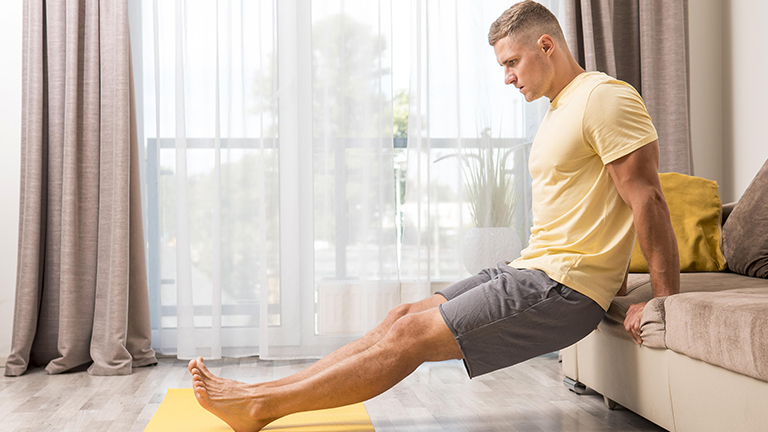Strengthen Weak Joints at Home Naturally: Joints are the foundation of movement in the human body, connecting bones and allowing flexibility, balance, and strength. Whether it’s walking, exercising, working, or performing daily tasks, healthy joints are essential for an active and pain-free lifestyle. Unfortunately, weak joints are a growing concern for people of all ages due to sedentary habits, poor diet, injuries, or age-related wear and tear. Ignoring weak joints not only causes discomfort but also increases the risk of arthritis, mobility issues, and chronic pain.
The good news is that you don’t always need expensive treatments or surgery to improve joint health. By focusing on natural remedies, simple home exercises, and dietary adjustments, you can strengthen weak joints from the comfort of your home. This article provides a complete, in-depth guide on how to strengthen weak joints at home, improve flexibility, reduce pain, and protect your mobility for years to come.
Understanding Joint Weakness
Causes of Weak Joints
Joint weakness does not occur overnight. It is usually the result of long-term factors that gradually reduce joint stability, flexibility, and strength. Some of the most common causes include aging, where natural cartilage wear reduces cushioning between bones, and lack of physical activity, which leads to weaker muscles supporting the joints. Injury from sports, accidents, or repetitive strain can also weaken joint structures over time.
Excess body weight is another major factor since it places added pressure on weight-bearing joints such as the knees and hips. Nutritional deficiencies, particularly lack of vitamins D, C, and calcium, also play a significant role in joint deterioration. Lastly, autoimmune conditions like rheumatoid arthritis and chronic illnesses can accelerate joint weakness.
Common Signs and Symptoms of Weak Joints
Recognising early signs of weak joints is crucial for timely prevention and care. Stiffness, especially in the morning or after long periods of sitting, is one of the most common symptoms. Weak joints often cause pain during movement, swelling, or even a grinding sensation known as crepitus. Reduced range of motion, frequent injuries such as sprains, and difficulty lifting or standing for long periods may also indicate compromised joint health.
Natural Remedies to Strengthen Joints at Home
Home-Based Therapies for Joint Health
Strengthening weak joints naturally begins with consistent home care. Warm compresses are effective for relieving stiffness and promoting blood circulation around weak joints. Cold therapy, on the other hand, reduces swelling and inflammation after exercise or injury. Gentle massages using warm oils like sesame oil, olive oil, or castor oil improve flexibility and ease discomfort.
Epsom salt baths are another powerful home remedy due to their magnesium content, which helps reduce muscle tension and support joint function. Applying turmeric paste or consuming turmeric tea may also provide anti-inflammatory benefits thanks to its active compound curcumin.
[INSERT_ELEMENTOR id=”5108″]
Herbal and Ayurvedic Remedies for Weak Joints
Herbal remedies have been used for centuries to restore joint health. Ginger tea improves circulation and reduces stiffness, while fenugreek seeds soaked overnight and consumed in the morning are known for their anti-inflammatory effects. Boswellia, also called Indian frankincense, is a traditional Ayurvedic herb proven to support cartilage and reduce joint pain.
Ashwagandha strengthens bones and muscles, while guggul is known for its ability to reduce joint inflammation. These herbal remedies, combined with proper diet and exercise, create a holistic approach to joint strengthening.
Best Exercises to Strengthen Weak Joints
Low-Impact Workouts for Joint Health
One of the most effective ways to strengthen weak joints at home is through low-impact exercises. Walking, cycling on a stationary bike, or swimming provides cardiovascular benefits without straining the joints. These exercises build muscle support around joints, which reduces stress and increases stability.
Yoga Poses to Improve Flexibility and Strength
Yoga is highly beneficial for joint flexibility and mobility. Poses such as downward-facing dog, warrior pose, and bridge pose stretch and strengthen joint-supporting muscles. Regular yoga practice improves balance, posture, and circulation, all of which contribute to stronger, healthier joints.
Strength Training for Joint Support
Strength training does not mean lifting heavy weights. Simple body weight exercises like squats, lunges, and wall push-ups help strengthen the muscles around major joints. Resistance bands are excellent for safe home workouts as they provide controlled tension. These exercises should be performed consistently but with proper form to avoid additional strain.
Diet and Nutrition for Stronger Joints
Best Foods for Joint Strength and Flexibility
Diet plays a critical role in joint health. Foods rich in omega-3 fatty acids such as salmon, walnuts, and flaxseeds reduce inflammation. Green leafy vegetables like spinach and kale provide calcium, vitamin K, and antioxidants. Citrus fruits such as oranges and lemons supply vitamin C, essential for collagen production and cartilage repair.
Vitamins and Minerals Essential for Joints
Vitamin D is crucial for calcium absorption, which strengthens bones and joints. Magnesium supports muscle function, while zinc aids in tissue repair. A diet balanced with these nutrients ensures better joint stability and resilience.
Hydration and Its Role in Joint Lubrication
Proper hydration keeps synovial fluid levels balanced. This fluid acts as a lubricant, cushioning joints and allowing smooth, pain-free movement. Drinking at least 8–10 glasses of water daily and incorporating water-rich foods like cucumbers and melons supports joint lubrication.
Lifestyle Changes for Healthy Joints
Posture and Movement Tips
Correct posture prevents unnecessary stress on joints. Sitting with a straight back, avoiding slouching, and ensuring ergonomic alignment while working on computers reduces strain on the spine, shoulders, and knees. Small adjustments in daily movements, like bending the knees instead of the back when lifting, also protect joint health.
Weight Management for Less Joint Stress
Maintaining a healthy body weight significantly reduces pressure on joints, especially the knees and hips. Even small reductions in weight can ease pain and prevent future joint damage. A balanced diet combined with regular exercise is key to managing weight effectively.
Daily Habits to Keep Joints Strong
Simple habits such as stretching in the morning, avoiding prolonged sitting, and incorporating movement throughout the day help keep joints flexible. Replacing high-impact activities with low-impact alternatives and ensuring adequate rest are equally important.
Preventing Future Joint Weakness
Avoiding Common Mistakes That Damage Joints
Many people unknowingly damage their joints through poor practices. Wearing unsupported shoes, neglecting warm-up exercises, or engaging in repetitive motions without rest can accelerate joint deterioration. Avoiding these mistakes helps in long-term preservation of joint strength.
Long-Term Strategies for Joint Protection
Consistency is the key to long-term joint protection. A combination of balanced nutrition, regular low-impact exercise, proper hydration, and mindful movement creates a foundation for lifelong joint health. Regular checkups and preventive measures reduce the risk of chronic joint issues later in life.
When to Seek Professional Help
Signs You Need Medical Attention
If joint pain persists for more than a few weeks, is accompanied by severe swelling, or affects mobility, it is essential to consult a healthcare professional. Sudden weakness or deformity in joints may indicate a serious condition requiring medical attention.
Role of Physiotherapy in Joint Strengthening
Physiotherapy is a valuable treatment option for weak joints. A physiotherapist can design personalized exercise programs to strengthen muscles, restore flexibility, and prevent further damage. In some cases, physiotherapy also aids recovery from injuries and post-surgical rehabilitation.
Conclusion
Weak joints can disrupt daily life and limit physical activity, but with the right care, it is possible to strengthen them naturally at home. By focusing on joint-friendly nutrition, home remedies, safe exercises, and lifestyle adjustments, you can significantly improve mobility and reduce pain. Prevention plays an equally important role—small, consistent steps today can protect your joints for years to come. If symptoms worsen or persist, seeking professional advice ensures safe and effective treatment.
Strong joints are not only about movement but also about independence, comfort, and quality of life. With dedication to natural practices and mindful living, you can keep your joints healthy, flexible, and strong for the long term.



